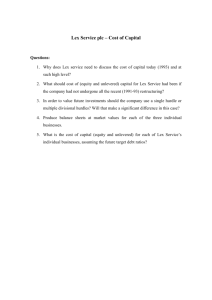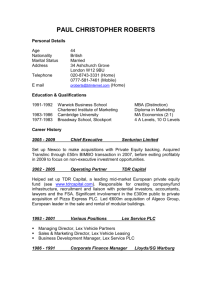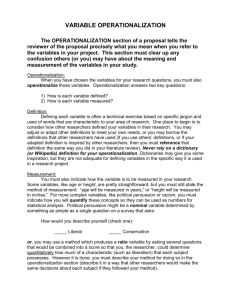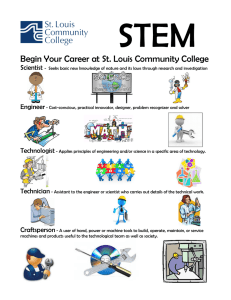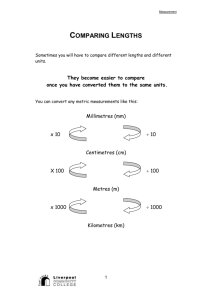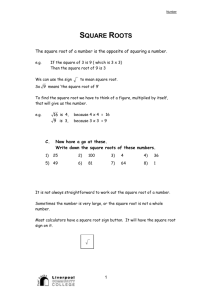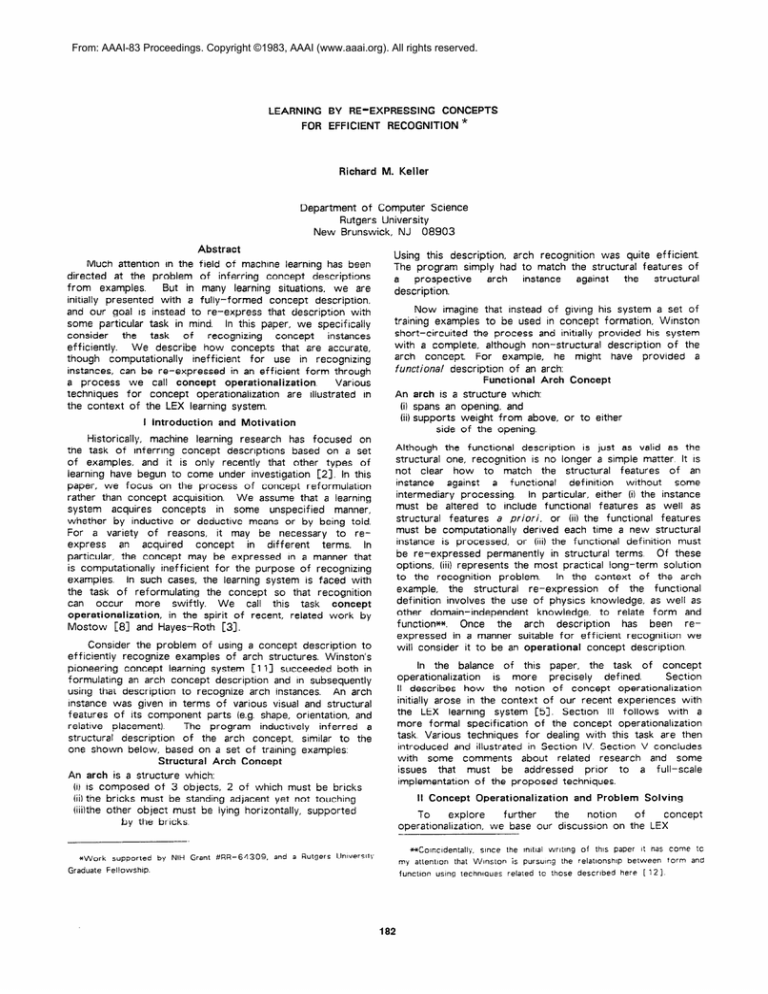
From: AAAI-83 Proceedings. Copyright ©1983, AAAI (www.aaai.org). All rights reserved.
LEARNING
FOR
BY
RE-EXPRESSING
EFFICIENT
Richard
CONCEPTS
RECOGNITION
M.
*
Keller
Department
of Computer
Science
Rutgers University
New Brunswick,
NJ
08903
Abstract
Much attention
in the field of machine learning has been
directed
at the problem
of inferring
concept
descriptions
from
examples.
But in many learning
situations,
we are
initrally presented
with a fully-formed
concept
description,
that description
with
and our goal IS instead to re-express
some particular
task in mind.
In this paper, we specifjcally
consider
the
task
of
recognizing
concept
instances
efficiently.
We
describe
how concepts
that are accurate,
though
computationally
inefficient
for
use in recognizing
instances,
can be re-expressed
in an efficient
form through
a process
we
call concept
operationalization
Various
techniques
for
concept
operationalization
are illustrated
in
the context
of the LEX learning system.
I Introduction
and
Motivation
Historically,
machine
learning
research
has focused
on
the task of inferrrng
concept
descriptions
based on a set
of examples,
and it is only recently
that other
types
of
learning have begun to come under investigation
[2].
In this
paper,
we focus
on the process
of concept
reformulation
rather than concept
acquisition.
We assume that a learning
system
acquires
concepts
in some
unspecified
manner,
whether
by inductive
or deductive
means or by being told.
For
a variety
of
reasons,
it may be necessary
to reexpress
an
acquired
concept
in
different
terms.
In
particular,
the concept
may be expressed
tn a manner that
is computationally
inefficient
for the purpose
of recognizing
examples.
In such cases, the learning system is faced with
the task of reformulating
the concept
so that recognition
can
occur
more
swiftly.
We
call
this
task
concept
operationalization,
in the spirit of recent,
related
work
by
Mostow
CS] and Hayes-Roth
[3].
Consider
the problem
of using a concept
description
to
efficiently
recognize
examples
of arch structures.
Winston’s
pioneering
concept
learning system
[ 1 I] succeeded
both in
formulating
an arch concept
description
and In subsequently
using that description
to recognize
arch instances.
An arch
Instance
was given in terms of various visual and structural
features
of its component
parts (e.g. shape, orientation,
and
relative
placement)
The
program
inductively
inferred
a
structural
description
of the arch concept,
similar to the
one shown below, based on a set of tralnrng examples:
Structural
Arch Concept
An arch is a structure
which:
(ij is composed
of 3 objects,
2 of which must be bricks
(ii) the bricks must be standing adjacent
yet not touching
(iiilthe other object must be lying horizontally,
supported
by the bricks.
*Work
Graduate
supported by NIH
Fellowship.
Grant
#RR-64309.
and a RWWrs
Unwrsltl
Using this description,
arch recognition
was quite efficient.
The program
simply had to match the structural
features
of
instance
against
the
structural
a
prospective
arch
description.
Now imagine that Instead of giving his system a set of
training examples
to be used in concept
formation,
Winston
short-circuited
the process
and inittally provided
his system
with a complete,
although non-structural
description
of the
arch
concept.
For
example,
he
might
have
provided
a
functional
description
of an arch:
Functional
Arch Concept
An arch is a
0) spans an
(ii) supports
side
structure
which:
opening, and
weight from above,
of the opening.
or to
either
Although
the functional
description
is just as valid as the
structural
one, recognition
is no longer a simple matter. It 1s
not
clear
how
to
match
the
structural
features
of
an
functional
definition
without
some
instance
against
a
In particular,
either 0) the instance
intermediary
processing
must be altered
to include
functional
features
as well as
or (ii) the functional
features
structural
features
a priori,
must be computationally
derived
each time a new structural
instance
is processed,
or (iii) the functional
definition
must
be re-expressed
permanently
in structural
terms
Of these
options,
(iii) represents
the most practical
long-term
solution
to the recognition
problem.
In the context
of the arch
the
structural
re-expression
of
the
functional
example,
definition
involves the use of physics knowledge,
as well as
other
domain-independent
knowledge,
to relate
form
and
function**.
Once
the
arch
description
has
been
reexpressed
in a manner suitable for efficient
recognition
we
will consider
it to be an operational
concept
description
In the
balance
of
this paper,
the task
of
concept
operationalization
is
more
precisely
defined.
Section
II describes
how the notion
of concept
operationallzation
initia!ly arose in the context
of our recent experiences
with
the LEX
learning
system
[5].
Section
III follows
with
a
more formal
specification
of the concept
operationallzation
task Various
techniques
for dealing with this task are then
introduced
and illustrated
in Section
IV. Section V concludes
with
some
comments
about
related
research
and
some
issues
that
must
be
addressed
prior
to
a
full-scale
implementation
of the proposed
techniques.
II Concept
Operationalization
To
explore
operationalization,
-wComcldentally,
my
attention
function
using
that
and
Problem
Solving
notion
of
further
concept
the
we base our dlscusslon
on the LEX
since
Wlnston
tecnmques
the
mltial
wrlttng
is pursuing
relared
to
the
those
of
this
paper
relatlonshlp
described
it nas
between
here
[ 12
come
form
1
tc
and
learning
system.
While
the
framework
proposed
in this
paper has not been incorporated
into LEX, it arises out of
our recent
experience
with this system,
and our attempt
generalize
upon its methods.
LEX is a program
which learns to improve
Its problem
solving
performance
in integral
calculus.
Problems
are
solved by the system using a least-cost-first
forward
state
space
search
method.
The
starting
state
in the
search
contains a well-formed
numeric
expression
with an integral
sign. LEX’s
task
is to solve
the
integral
by applying
a
sequence
of operators
that will transform
the starting state
into one containing
no integral sign. A set of approxrmately
50 calculus and arithmetic
simplification
operators
is initially
given to the system. Each operator
specifies
(i) an operation
to be performed,
and (ii) a set of numeric
expressions
to
which the operator
may legally be applied.
Here are three
sample operators:
OP 1: jsin(x)dx
---) cos(x)
OP2: Sk f(x)dx k-ff(x)dx
OP3 Integration
by Parts:
j.f l(x)*f2’(x)dx
*
f l(x)*f2(x)
- +ff2(x)*f l’(x)dx
where
k:constant,
f(x):function,
and f’(x):derlvative
of f(x)
positive
classificatory
decision
Once the relevant
features
have been identified,
LEX generalizes
the positive
instance
by discarding
irrelevant
features
The generalized,
rather
than the original,
positive
instance
IS
then
fed
to LEX’s
inductive
constructs
instances
learnlng
mechanism*w*?
This
mechanism
then
an efficient
method
for
recognizing
positive
based on syntactic
patterns
in the instances
l
As LEX solves
problems,
it learns to prune Its search
tree
by refusing
to apply
operators
in those
situations
where
experience
has
shown
an
application
to
be
“nonproductive”,
although legal. For example,
it is often legal
‘integration
by
parts’
(whenever
the
integral
to
apply
contains
a product),
but it is much less frequent
that the
application
will lead to a solution.
The criterion
to use in
deciding
whether
an
operator
application
is
to
be
considered
productive
or nonproductive
is given
to the
system initially as the Minimum Cost Criterion
shown below:
Minimum
Cost
Criterion:
Any
operator
application
that
extends
the
search
tree
in the
direction
of
the
minimum cost*w
solution
is considered
a productive
operator
application.
LEX’s learning task is to acquire
the ability to efficiently
distinguish
between
productive
and nonproductive
operator
applications
By definition,
this ability should
improve
the
system’s
problem
solving
behavior.
Note
that
with
prior
knowledge
of the Minimum
Cost Criterion,
LEX begins
by
knowing
in
principle
distinguish
how
to
between
productive
and nonproductive
operator
applications:
simply
expand
the search
tree
until a minimum
cost
solution
is
then
applications
found
and
classify
the
operator
accordingly.
However,
this method
is grossly
self -defeating,
since
a
process
that
simply
deliberates
about
which
operator
to apply
next cannot
be granted
the luxury
of
conducting
an exhaustive
search
for
the
minimum
cost
solution’
Although
direct
use of the Minimum
Cost Criterion
to
recognize
productive
operator
applications
is prohibitive,
the
Criterion
is used by LEX in other
significant
ways.
The
most
recent
version
of
LEX****
[6]
employs
both
a
procedural
and a declarative
representation
of the Criterion
in the
processing
of
Instances.
Initially,
the
procedural
Criterion
(called the CRITIC) classifies
an individual training
instance
(i.e. an operator
application)
as positive
or negative
(productive
or nonproductive).
If the instance is positive, the
declarative
Criterion
is then used to analyze which features
of the instance
were
specifically
relevant
to the CRITIC’s
**Cost
IS measured
by cpu ttme
expended
to reach
tne
goal
state
Let us describe
a subset of the RL that IS of particular
interest.
The efficient
recognizer
language
(ERL) contains
only
those
RL
terms
that
describe
either
(i) features
encoded
directly
in instances,
or
(ii) features
efficiently
computable
from
encoded
features.
Any
RL term
that
references
other
types
of
features
is
part
of
the
IRL
(inefficient
recognizer
language).
Finally,
we
will
define
a recognizer
expressed
solely In terms
of the ERL
to be an operational
recognizer******.
Notice that for the
arch
example,
the
RL
IS
a
language
containing
both
functional
and structural
terms,
while the ERL is restricted
to structural
terms
and the IRL IS restricted
to functional
terms
Thus, the structural
arch recognize:
is operatlonal.
while the functlonal
arch recognizer
is not
We
I I components
on several
examples,
of
this
versron
but have not
been
have been
completely
Implemented
Interfaced
and tested
now
In a position
Concept
to define
our
Operationalization
task.
Task
Given:
1. Recognizer
language RL,
2. Efficient
recognizer
language ERL where
ERL o RL,
3. Inefficient
recognizer
language IRL where
IRL=RL-EEL,
4. Recognrzer
R, expressed
in RL, containing
IRL terms
Find
An operational
which
Mx*+Slnce
number
of
negative
matter
instances
formulatrng
operationallty
of
of
degree
instance
out
of
In
thts
In the
instances
represents
has
a single
the
one.
manner,
a
effect
LEX
although
ERL,
as R
set
of
of
does
the
posltlve
squeezing
not
a
currently
corresponding
in prlnctple.
recognrzer
a
same
technique
Instances
IS feastble
Mm*+ln
analysis
ER, expressed
the
generalized
LEA
trarnrng
generalrze
analysrs
recognizer,
recognizes
the
the
instances.
that
***/A
are
thus problem,
is
a
recognizer
we
make
operatronal
either
IS
more
the
or
properly
simplrfying
assumption
nonoperational
consrdered
The
to
be
a
Informally,
the task here is to move a recognizer
into
the ERL so that It can be used for
efficient
recognition
Since
the
set of
positive
instances
recognized
by R is
never
explicitly
given, a major
difficulty
with this task lies
in proving
that a candidate
ERL recognizer
will identify
the
same set of positive
instances
as R. Our approach
to the
task
addresses
this
problem
by
applying
a series
of
transformations
to R that have well-defined
effects
on the
set of
instances
recognized
by R. Another
problem
with
this task concerns
what to do when there
exists
no ERL
recognizer
that identifies
all of the positive
instances
There
are primarily two options
available in this case: (i) settle for
an ERL recognizer
that identifies
a subset
of the positive
instances,
or
(ii) expand
the
ERL
until
an
appropriate
recognizer
is included
in the
ERL. The
second
option
involves finding an appropriate
IRL term to incorporate
into
the
ERL,
and
then
developing
an efficient
method
of
computing
the
feature
described
by the
IRL term.
This
approach
has been pursued
by Utgoff
[lo].
On the
other
hand,
consider
the
followlng
recognizer
which is expressed
in LEX’s ERL
POS-INST-A(OP3,state)c
MATCH(J-trlg(xj*poly(x)dx,
Expression(state1)
ERL terms have been restricted
to apply solely to features
of integral
calculus
expressions
If specific
features
are
present
in an expression,
then the features
are said to
MATCH
the
expresslon
A feature
MATCH
IS
efflclently
computable
from the instance data structure
with the aid of
a grammar
IRL Recognizer
calculus
Meaning
PREDICATES
example,
if
POS-INST-A(OP3,
Ssin(x)* 3x*dx),
we
is
a
whether
sin(x)
determine
trigonometric
and 3x2
function
section
will
into a more
is a polynomial
illustrate
efficient
iV Operationalization
A.
General
description
of
function.
how POS-INST-0
ERL recognizer.
can
Techniques
techniques
In Table IV- 1 we describe
and characterize
a number
of
operatlonalization
techniques
definitional
expansion,
enumeration,
redundancy
elimination,
constraint
propagation,
disjunct
selection,
instantiation,
conjunct
addition
and conjunct
deletion
Each technique
consists
of a single replacement
rule that can be used to transform
a predicate
calculus
subexpression
found
in a recognizer.
For
example,
we
can
use
Definitional
Expansion1 to
transform
Foo(x)hBaz(x)
into Bar(x)hBaz(x)
if we know that
Foo(x)*Bar(x).
Starting
with a non-operational
recognizer,
the replacement
rules are sequentially
applied with the goal
of transforming
IRL terms into ERL terms
This process
will
be illustrated
in the next subsection.
for
productive
operator
applications
GOAL(state)
[APPLICABLE(op,state)
A SOLVABLE(Successor-state(op,state)Il
of
For
we want to evaluate
invoke
MATCH
to
POS-INST-O(op,state)++
-GOAL(state)
A APPLICABLE(op,state)
A SOLVABLE(Successor-state(op,state))
A
[(Votheropeoperators
1otheropfop)
-APPLICABLE(otherop,state)
v -SOLVABLE(Successor-state(otherop,state)I
v
MORE-COSTLY-STATE(Goal-state-reachable(otherop,state),
Goal-state-reachable(op,state))l
SOLVABLE(state)++
v 3op
C 101
expresslons
Each
operatlonakzation
technique
dlscussed
in
this
section
specifies
a transformation
that can be applied to a
given recognizer
in order
to produce
a new, and hopefully
more efficient
recognizer.
The set of techniques
described
IS intended
to
be
general,
although
not
comprehenslve.
Consult [8]
for Mostow’s
thorough
treatment
of a broader
spectrum
of operationalization
techniques
Note
that POS-INST-0
contains
reference
to features
(e.g.
solvability and cost) which are neither directly encoded
nor easily derivable
from
the instance
data structure.
For
example,
to determine
whether
STATE
is SOLVABLE,
It is
necessary
to complete
an exhaustive
search of the subtree
beneath
STATE.
Furthermore,
to
compute
the
cost
of
STATE requires
a complete
record
of all operators
applied
to reach STATE from the root of the search tree.
Due to
these
lnef f iciencies,
POS-INST-0
is non-operational
and
terms
such as SOLVABLE
and MORE-COSTLY-STATE
are
part of LEX’s IRL.
III -1:
for
In the next
be transformed
We
are now
in a position
to illustrate
how we view
LEX’s learning
task in terms
of operationalization.
Figure
Ill- 1
LEX’s
non-operational
Minimum
presents
cost
Criterion,
phrased
in terms
of a recognizer
in predicate
calculus.
The
POS-INST-0
predicate
recognizes
only
productive
operator
application
instances.
The instance
data
structures
are pairs of the form
(OP,STATE),
where
OP is
to be applied
to the integral
calculus expresston
contained
in STATE.
In order
for
(OP,STATE)
to
be a posltlve
instance,
POS-INST-0
specifies
that STATE must contain a
non-solved
integral
expression,
and that the application
of
OP to STATE
must produce
a new state that lies on the
path to a solved
expression.
Furthermore,
no other
path
should lead to a less costly solution.
Figure
example
(uppercase)
and
Functions
(capitalized):
POS-INST-O(op,state).
the application
of op to state is productive
II SOLVABLE(state):
there is a path leading from state to a goal state
q
m APPLICABLE(op,state):
legal to apply op to state
q
GOAL(state):
state is a goal state
m MORE-COSTLY-STATE(state
l,state2)
cost to state 1 exceeds
cost to state2
m Successor-state(op,state).
returns state resulting from application
of op to state
IJ Goal-state-reachable(op,state).
returns goal state at the end of the path starting
with the application
of op to state
184
1 REPLACEMENT
1 TECHNIQUE
where
I
1
1
1
Z=f
-1
We know that the use of this expansion
causes overspecialization
because
our knowledge
about Integration
operators
informs
us that
OP3
cannot
actually
be
applied to any state produced
by OPl
RULE
CONCEPT-PRESERVING
TRANSFORMS
1 Definitional
Expansion1
1 Replace A wdh B If A B
Replace
[ Vx ] f(x) with f(A)Af(B)A
1 Enumeration
TRedundancy
Elimination
) Replace
(ANBAA))
with (BAA)
Replace
c(X.f(Y))
with c(Z.YL
1 Constraint
Propagation
1
8
(X)
IV-l:
OPERATIONALIZATION
TECHNIQUES
B. Operationalization
It is useful
to view the operationalization
process
in
terms
of a heuristic
search
through
a space
of concepts,
where
states
in the space
are recognizers
and operators
are operationalizing
transforms.
The starting state represents
the
initial IRL recognizer.
The
goal
states
contain
ERL
recognizers
that identify the same posittve
instances
as the
Initial IRL recognlzer.
(Failing this, the goal states are those
that identify the largest number of positive
instances.) There
are various pieces
of knowledge
that can be used to guide
this search. Broadly, these include:
@ Kno;Nledge
about
the
effect
of
a transform
of
instances
recognized
as positive.
Any
which modifies
this set should be avoided.
on the
Ex: A definition
MATCH
translates
expressing
parts
terms of GOAL is
recognlzer
INST-0
sequence
set
transform
that expresses
GOAL
in terms
of
between
the IRL and the ERL. Reof
the
original
IRL recognizer
In
therefore
a useful subtask.
that
past
have
These
Ex:
To
provide
guidance
in
the
selection
and
expansion
of clauses
in an IRL recognizer,
it may be
possible
to use a previously-formulated
transformation
In this way,
sequence
as a a kind of macro-operator.
the construction
of a new sequence
could be guided
by previous
experience.
@ Domain-specific
knowledge
prevent
the over-specialization
Ex:
recognizer
Any
def lnitional
instantiated
(defined
in Figure
Ill- 1)
instances at all:
that
can
be
used
of a recognizer.
containing
expansion
IS legal,
GOAL(Successor-state(OP3,Successor-statelOP
applied
to
LEX
In
IS
in
in
In
IRL
for
productive
operator
applications
(POSIll- 1).
One
possible
transformation
Figure
depicted
in Figure IV-2
dperationalization
of POS-INST-0
Figure
W-2:
POS-INST-0
(from Figure Ill- 1)
1 4 Via Disjunct
Selection
on -APPLICABLE
1
‘POS-INST1 (op,state)+
-GOAL(state)
A
APPLICABLE(op,state)
A SOLVABLE(Successor-state(op.state)I
A
[(Votherop=operators
1otherop#op)
-APPLICABLE(oth&op,state)]
J- Via Definitional
Expansion-l
on SOLVABLE
I
POS-INST-2(op,state+
-GOAL(state)
A APPLICABiE(op,state)
A
[GOALtSuccessor-state(op,state)J
v 3opx (APPLICABLE(opx,
Successor-state(op,state))
A SOLVABLE(Successor-stateiopx,
Successor-stat&op,state)III
1
A
[(Votherop=operators
otherop#op)
-APPLICABLE(oth&-op,state)]
1 4 Via Disjunct
Selection
on GOAL
I
POS-INST-3(op,state)+
-GOAL(state!
A
APPLICABLE(op,state)
A
GOAL(Successor-state(op,state))
A
[WotheropEoperators
1otherop+op)
-APPLICABLE(otherop,state)]
1 4 Via Instantiation
of op,Enumeration
of -APPLICABLEI
POS-INST-4(0P
1 ,state)+-GOAL(state)
A
APPLICABLE(OP 1 ,state!
A
GOAL(Successor-state(OP
1 ,state))
A
-APPLICABLE(OP2,state)
A
-APPLICABLE(OP3,state)
which IRL terms have ERL
can be used in means-
* Examples
of
transformation
sequences
resulted
In useful
ERL recognizers
in the
can be used to focus the search.
techniques
To more
fully
illustrate
the techniques
introduced
Section
IV.A, we would like to illustrate operatlonalizatlon
the
context
of
a specific
hand-generated
example
consider
the task of operatlonallzing
LEX’s
particular,
Ex: If only concept-preserving
transforms
are used
during concept
operationalization,
the set of instances
recognized
by the final ERL recognizer
is guaranteed
to be identical to the set recognized
by the initial IRL
recognizer.
On the other hand, concept-specializing
transforms
reduce
the
set
recognized
as positive,
while
concept-generalizing
transforms
enlarge
the
set so that some
negative
instances
will be falsely
included
as positive.
Concept-generalizing
transforms
are therefore
the most dangerous
type to apply during
concept
operationalization
@ Definitional
knowledge
about
This knowledge
expansions.
ends guidance.
of the
serve to
Ex: If the predicate
Red(x)
is not In our ERL, It may
be necessary
to perform
Conjunct
Deletion
to remove
it from
the expression
Red(x)ARound(x)AHeavy(x)
To
justify the use of this concept-generalizing
transform,
it may be helpful
to know
that i) the goal of the
system in question
involves (for example)
learning how
to make
efficient
use of mechanical
equipment,
and
that
ii) color
does
not
generally
effect
mechanical
properties
CONCEPT-SPECIALIZING
TRANSFORMS
Replace A with B ff B +
A
Def lnitional Expansion-2
Replace (AAB) with (AABAC)
Conlunct
Addition
Replace (AWVC)
with B
Disjunct Selection
1 Replace
3x 1 f(x) with f(A)
Instantiation
CONCEPT-GENERALIZING
TRANSFORMS
1 Replace
(AABAC)
with (AAC)
Conjunct
Deletion
Definitional
Expansion-3
1 Replace A wltr‘ B If A ---$ B
Table
Knowledge
about
the goals
and constraints
learning system
This type of knowledge
can
justify the use of a concept-altering
transform
A
-APPLICABLE(OPN,state)
1J
-MATCH(expr-with-no-J,state)
POS-INST-5(0P
1 ,state+
A
MATCH(Jsin(x)dx,state)
A
MATCH(expr-with-no-S,Successor-state(OP
1 .state))
A
-MATCH(Jk
* f (x)dx,state)
A
-MATCH(Jf
1 (x) . f 2’(x)dx,state)
.
.
to
the
following
of
SOLVABLE
but
identifies
no
A
-MATCH(Precondltlons(OPN),state)
Via Constraint
Propagation
MATCH(expr-with-no-S,Successor-state(OP
1 ,state!)
I
==> MATCH(f (x)-l-sin(x)dx,statei
-i
1
and Redundancy
Elimination
POS-INST-6(OP
1 ,state)+MATCH(f(x)Jsln(x)dx,state!
1 ,statel)I
185
I
VI
To motivate
this operationalization
sequence,
consider
applying means-ends
analysis to the task. In order
to arrive
at an ERL recognizer,
it is necessary
to apply a technique
that translates
IRL predicates
into ERL predicates.
The only
such technique
available
is Definitional
Expansion.
Among
those
predicate
definitions
that translate
between
the IRL
and the ERL are:
APPLICABLE(op,state)
*
MATCH(Preconditions(op).
GCAL(state!
MATCH(term-with-no-S,
Expression(state)),
Acknowledgments
I would
like to thank Tom Mitchell
for
his significant
contribution
to the ideas expressed
in this paper,
and for
his help and encouragement.
Many of my ideas have also
been clarified
by discussions
with Smadar
Kedar-Cabelli.
I
thank Paul Utgoff
for his assistance
in implementation
and
for several
careful
readings
of earlier drafts
of this paper.
John Bresina, Donna Nagel, Don Smith, and Peter Spool also
supplied useful comments
and
References
Expression(state)).
The transformation
sequence
shown
can be viewed
as an
attempt
to
re-express
POS-INST-0
solely
in terms
of
APPLICABLE
and
GOAL.
This
has
been
accompllshed
in
POS-INST-4.
From this point, it is easy to move into the
ERL. The final step of the sequence
produces
POS-INST-6,
which
recognizes
the application
of OP 1 to STATE
as a
productive
operator
application
whenever
Jsin(x)dx
appears
within the numeric expression
contained
in STATE.
While
LEX
does
not
actually
represent
the
operationalizing
transforms
of Table IV- 1 explicitly,
there is
a close relationship
between
the operationalization
sequence
in Figure IV-2
and its counterpart
in LEX.
In particular,
the
process
(explained
in Section
II) that LEX goes through
in
analyzing
a single positive
instance
can be vlewed
as the
application
of a sequence
of
operationalizing
transforms
This sequence
changes
POS-INST-0
into a very
specific
ERL recognizer
that
identifies
only
the
single
Instance
However,
the transformation
sequence
can then be used a
template
for the construction
of a new sequence
leading to
a more
general
recognizer.
By using the equivalent
of a
template,
the LEX implementation
eliminates
much of the
search process
inherent in operationalization.
Selection
and
expansion
of clauses
is carried
out in accordance
with the
template,
and
Constraint
Propagation
and
Redundancy
Elimination
are
automatically
invoked
after
IRL predicates
have been
translated
into the ERL. The use of conceptgeneralizing
transforms
is avoided
altogether.
These
precompiled
decisions
have made
the LEX operationalization
task
manageable,
and have permitted
us to avoid
some
difficult
control
issues that arise in the full-blown
concept
operationalization
scenario
described
in Section 1V.A.
V Conclusions
The operationalization
techniques
described
in this paper
are not particularly
novel; similar methods
have been applied
to automated
design and synthesis
tasks (see, for example,
work
in automatic
programming
[4, 11). What
is different
about
our
approach,
along
with
Mostow’s
[9],
is the
explicit
application
of these
techniques
in the context
of
learning
and problem
solving [7, 61. We are beginning
to
acknowledge
that design activities
are intimately
related
to
learning abilities, and that the ability to use one’s knowledge
appropriately
to achieve
a particular
goal (i.e to design a
solution to a problem)
is a fundamental
learning skill.
It is clear that much work
remains
to be done in the
area of controlllng
the search for solutions to the concept
operationalization
task. In particular,
we need to understand
how various
sources
of knowledge
can be used not only
to guide, but also to justify
the operationalizatlon
process
Justif ication
involves
the
defense
of
operationalization
decisions
based
on
goals,
constraints
and
preferences
operating
within the concept
learning environment
Based on
the nature
of recent
research
in machine
learning,
more
attention
to
such
environmental
factors
is
central
to
progress
in this field.
111
Barstow,
Algorithms
Knowledge
dissertation,
c21
Carbonell,
J. G., Michalski,
R. S. and Mitchell,
T. M.,
Machine
Learning,”
Machine
“An
Overview
of
Learning,
Michalski,
R S.,
Carbonell,
J G
and
Mitchell, T. M. (Eds.), Tioga, 1983.
c31
Hayes -Roth,
F., Klahr,
P., Burge,
J. and Mostow,
D. J., “Machine
Methods
for Acquiring,
learning, and
Technical
Report
R-624
1, The
Applying Knowledge”,
RAND Corporation,
1978.
L-41
“Knowledge
and
Waldinger
R.,
Manna,
Z. and
Reasoning
in Programming
Synthesis,”
Studies
in
Logic,
Manna,
Z. and
Automatic
Programming
Waldinger
R. (Eds.), North-Holland,
1977.
c51
Mitchell,
T. M.,
Utgoff,
P. E. and
Banerji,
R. B.,
“Learning by Experimentation:
Acquiring
and Refining
Machine
Learning,
Heuristics,”
Problem-Solving
Michalski,
R. S., Carbonell,
J. G and Mitchell,
T. M
(Eds.), Tioga, 1983.
C61
Mitchell,
T.,
Proceedings
August
1983.
II71
Mitchell,
Learning,”
Machine
1983.
C81
Mostow,
D. J., Mechanical
Transformation
of
Procedures,
into
Operational
Heuristics
dissertation,
Carnegie-Mellon
University,
198 I.
c91
Transformation
of Advice
Mostow,
D. J., “Machine
Heuristic
Search
Procedure,”
Machine
into
a
Learning,
Michalski,
R S.,
Carbonell,
J G
and
Mitchell, T. M. (Eds.), Tioga Press, Palo Alto, 1983
Cl01
Utgoff,
P. E. and
Mitchell,
T. M., “Acquisition
of
Inductive
Concept
Learning,”
Appropriate
Bias for
Proceedings
of the Second
National
Conference
on
Artificial
Intelligence.
Pittsburgh,
August
1982.
Cl 11
Wlnston,
P. H.,
from
Examples,”
Vision,
Winston,
1975,
ch. 5.
II121
Winston
P.H., Binford
T.O., Katz B. and Lowry
M.,
“Learning
Physical
Descriptions
from
Functional
Third
Precedents,”
and
Definitions,
Examples,
Automatic
Construction
of
D. R.,
Structures
Using
a
and
Data
Base
of
Programming
Rules,
Ph.D
Stanford
University,
November
1977.
“Learning
/ JCAI
of
and
- 83,
Solving,”
Germany,
T. M.
and
Keller,
R. M.,
“Goal
Directed
Proceedings
of the Second
International
Learning
Workshop,
Urbana,
Illinois, June
Task
Ph.D.
“Learning
Structural
Descrlptlons
The
Psychology
of
Computer
P. H. (Ed.), McGraw
Hill, New York,
National
Conference
on
Washington,
D.C., 1983.
186
Problem
Karlsrhue,
Artificial
Intel
t igence

